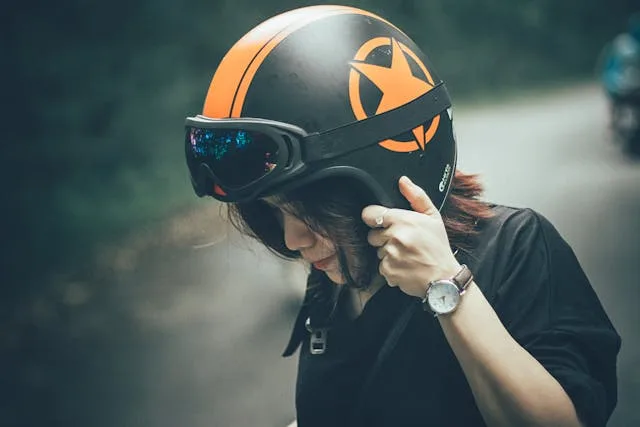Your Guide to Motorcycle Helmet Types: Features, Pros, and Cons
One of the most critical pieces of safety gear for any rider is the motorcycle helmet. Helmets come in various types, each designed to offer different levels of protection and comfort. Understanding the different types of motorcycle helmets can help you choose the one that best suits your riding style and needs.
Full-Face Helmets
Description and Features
Full-face helmets provide the most comprehensive coverage, protecting the entire head, including the chin and face. These helmets feature a solid outer shell, a visor to shield the eyes, and ventilation systems to ensure airflow. The full coverage design is intended to offer maximum protection against impact and debris.
Pros and Cons
The primary advantage of full-face helmets is the superior protection they offer. They are particularly effective in shielding the face and chin, which are vulnerable areas during a crash. Additionally, the visor protects the eyes from wind, dust, and insects, enhancing visibility and comfort. However, some riders may find full-face helmets to be heavier and less ventilated compared to other types, which can lead to discomfort during long rides or in hot weather.
Modular (Flip-Up) Helmets
Description and Features
Modular helmets, also known as flip-up helmets, combine features of both full-face and open-face helmets. They have a chin bar that can be lifted, transforming the helmet from a full-face to an open-face configuration. This dual functionality makes them a popular choice among touring and adventure riders.
Pros and Cons
The versatility of modular helmets is their biggest advantage. Riders can enjoy the protection of a full-face helmet and the convenience of an open-face helmet without having to switch helmets. This makes it easier to communicate, eat, or drink without removing the helmet entirely. However, the hinge mechanism adds weight and complexity, making modular helmets slightly less secure and heavier than standard full-face helmets. Additionally, the flip-up design can create additional noise and reduce aerodynamic efficiency.
Open-Face (3/4) Helmets
Description and Features
Open-face helmets cover the top, back, and sides of the head but leave the face exposed. These helmets typically include a visor to protect the eyes, but they lack a chin bar, offering less protection for the face.
Pros and Cons
Open-face helmets are favored for their greater visibility and airflow, making them more comfortable in hot weather. They provide a more open and less confined feel compared to full-face helmets. However, the lack of chin protection is a significant drawback. In the event of an accident, the face is exposed to impacts, increasing the risk of injury. Riders must weigh the trade-off between comfort and safety when considering an open-face helmet.
Half Helmets
Description and Features
Half helmets offer minimal coverage as they only protect the top of the head. They are lightweight and often do not include a face shield or visor.
Pros and Cons
The primary advantage of half helmets is their lightweight and minimalistic design, which provides a sense of freedom and less restriction. They are easy to put on and take off and are ideal for short rides and low-speed cruising. However, they offer the least protection among all helmet types. With no coverage for the face, chin, and lower back of the head, riders are significantly more vulnerable in the event of a motorcycle crash.
Off-Road (Motocross) Helmets
Description and Features
Off-road helmets are specifically designed for dirt biking and motocross. They feature an extended chin bar and a peak or visor that provides shade and deflects debris. These helmets are built to withstand the rigors of off-road riding.
Pros and Cons
Off-road helmets offer specialized protection for off-road conditions. The extended chin bar provides extra ventilation, while the peak shields the rider’s eyes from the sun and debris. These helmets are lightweight and well-ventilated, making them comfortable for intense physical activity. However, they are not ideal for highway use due to their lack of aerodynamic design and noise insulation.
Dual-Sport (Adventure) Helmets
Description and Features
Dual-sport helmets, also known as adventure helmets, are a hybrid between off-road and full-face helmets. They feature a visor and peak combination, allowing them to be used both on-road and off-road.
Pros and Cons
The versatility of dual-sport helmets makes them a popular choice for adventure riders who switch between on-road and off-road riding. They provide adequate protection and comfort for both environments. However, dual-sport helmets can be bulkier and heavier than standard helmets, and the peak can cause wind drag at high speeds on highways.
Making Your Decision
Choosing the right motorcycle helmet is essential for your safety and comfort. Each type of helmet offers different levels of protection and features suited to various riding styles and conditions. Full-face helmets provide the best overall protection, while modular helmets offer versatility. Open-face and half helmets offer more comfort and freedom but at the cost of reduced protection. Off-road and dual-sport helmets cater to specific riding conditions and needs. Ultimately, prioritizing safety and ensuring a proper fit will help you select the best helmet for your riding adventures.



